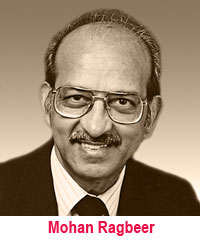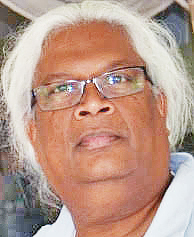Opinions
More on Oil

To their credit, the local media have insisted on transparency, and have noted the many avenues for corruption and blatant self-aggrandisement, nurtured by successive governments in the last 50 years, and likely to increase, lubricated by oil. An obvious one is the use of Guyanese companies – middlemen or lobbyists – to get government favours for overseas oil service companies. The numbers of new faces in the hotel lobbies or Ministry waiting rooms should tell. How many non-white faces are there? If any, make sure it’s not a Tobiang, with a suitcase full of cash and jewels, as he recently revealed in Brazil. The scene is repeated all over the developing world, where leaders fatten on payola by rich industrialists who couldn’t care less about the people or the environment. This has not changed since the dawn of imperialism and laissez faire capitalism. But one can be alert and create strong laws and an ethical justice system to deal with corruption.
For a year President Granger has had an expert in off-shore petroleum mining, Dr Jan Mangal, an expatriate Guyanese with 18-years’ experience, 13 working with Chevron on offshore oil, completing his projects on time and under budget, in the Philippines, USA and elsewhere. But his contract was terminated earlier this year, most likely for speaking bluntly, at a UG seminar and elsewhere, on Guyana’s unpreparedness, noting the misplaced trust in EM, and that the 2% royalty was below world standards. He had urged the hiring of “experts” on offshore oil, besides him, and suitable technical staff for the Ministry of Natural Resources, complaining that none had been procured in two years. He opposed a National Oil Company, despite positive comments from Chatham Consulting of London. He had advised on structuring the industry, management, and the need to safeguard the National Fund, e.g. by engaging an experienced and trustworthy Bank to assist the Bank of Guyana and other financial institutions, in an area where they had no experience, and the regional models e.g. Trinidad and Jamaica, were failures. Despite a century of oil wealth, Trinidad lacks necessities for over half the population, and loses skilled people by migration. It gutted its agriculture and abandoned sugar in 2007. Its economy is lopsided, heavily reliant on petroleum, now mainly gas, and has had negative growth in the last few years. Like Guyana, its politics is based on race, although eliminating race will not guarantee success; witness Jamaica, where both major parties are similar racially, by people and philosophy.
The project needs an independent oversight, outside of EM and Government. The industry needs stability, and therefore must not be run by intermittent politicians. Hopefully, the pending legislation to govern it will be thoughtful and comprehensive, giving a solid base for regulation and financial management.
Photograph a window to the past
 Romeo Kaseram
Romeo Kaseram
There are a few early photographs of the family that I recall. There is “The One”, meaning it is our very first photograph of family members, as far as I know, that goes back to late 1950s with my auntie wearing her wedding dress. She is obviously the centre of attention; standing next to her is a phlegmatic and unimpressed grandfather, and then my young uncle, who is looking warily into the camera with eyes wide and appears ready to flee, his young body tense in the micro-moment, anxiously awaiting the unexpected.
This photograph is the only window the family has that captures a major early event, which was the wedding day of my auntie. The details are few that have been passed down on the how, and why, this photograph came to be taken.
Obviously, it was my auntie’s wedding day, and what I have been told from the many fading memories, and worse, the fading tonalities to which these cracking narrating voices belong, the decision to make the long trip to the town from the village where my grandparents, my young mother-to-be, and my uncles lived, may have been an impulsive act by my grandfather.
However, I have always doubted that piece of information. From my grandfather’s mien, the obvious posture of obstinacy in his body language, and his lack of a smile on such a happy occasion, it seems to me he was not one inclined to be impulsive. It would have taken some logistics to arrange transport to the town, which he would have done, likely with the one or two owners of vehicles back then.
It is for this reason that I believe my grandfather may have done some pre-planning, budgeting, and perhaps cajoling of the reluctant owner of the vehicle, for such an expensive enterprise as a trip to the nearby town, for of all things, a photo-shoot. I wonder if the owner of the vehicle would have raised an eyebrow at the extravagance of taking such a long trip to the town.
I see my grandfather sitting in the front, my auntie timid, minding her dress did not crease, and my excited uncle rolling down the window to savour the new air. I hear my auntie complaining to my grandfather that the incoming air was ruffling her hair, and my uncle being forcefully ordered to roll it back up.
Perhaps the photograph was a surprise, a gift for both my auntie and her husband, and for my grandmother who remained behind with the invited guests. But then again, it could be this was not so, since the look on my grandfather’s face, captured in this photograph, speaks volumes to the sternness, parsimony, and a forcefulness of character evidenced in the stories that have been told by my mother and uncles about his hard-headedness.
Indeed, over the decades I have scrutinised this photograph, and the impenetrable face of this puzzling patriarch, searching for the barest crack in its exterior, for an entrance leading to the other side of this phlegmatic image: it is a search for a kind of reassurance, told to me by my mother of a father who came home each evening with sweets hidden in his pockets for his children.
In the years ahead I know I will continue to search, as I have done since I was a boy, a young man, and now an adult, seeking to look into the past, wondering why he had steeled himself to the imminence of the flash, presenting an exterior for all futurity of a man stolid and unassailable.
Other than these unresolvable avoidances to knowledge contained in this photograph of my grandfather, his wedded daughter, and an anxious son, it remains as remains, as a decaying not only of a time long past, but of itself as well in its aging paper that is now faded, yellow on the edges, its gloss cracked in places. But thankfully copied, and in recent years, digitised, and now endlessly shared, its indexicality framed in the eternity of social media circulation.
I know its inherent enigmas will persist, that despite my auntie starring as its centrality, garbed in her white dress, her orhini an indicator of her religiosity, and holding a spray of cut flowers, no doubt from a neighbour’s garden, there would always be another eternity trailing in its black and white.
For in this eternity are my grandfather and uncle framed in quotidian poses – there is nothing in their demeanour that is celebratory and unusual; they are both caught in individual moments that reflect their everyday as prosaic living in that moment of 1950s time. Thus this photograph has reproduced two different worlds: the celebratory that is a wedding, and the everyday lives of a patriarch and his son.
Some days when I look at this photograph, I wonder at the world beyond its frame: it would have been nice if my grandfather had envisioned a family shoot. I wonder how flustered my young mother-to-be would have been on her sister’s wedding day; and I know, beyond doubt, that Ma would have cried.
